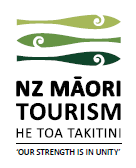This column was first published in Tourism Ticker
It’s Māori Language Week and NZ Māori Tourism’s chief executive, Pania Tyson-Nathan, tells us how learning the language is an ongoing journey and the value of Te Reo to tourism.
Kia ora te Reo Māori! Kia ora hoki ki a tātou katoa nō te ahumahi tāpoi o Aotearoa nei. Whakanuia te Reo Māori.
Every Wednesday morning one of my staff comes into the office buzzing. ‘Guess what I learned at Reo class last night’ – and then she’ll proceed to share with us her learnings, waiata, kupu, and history she, along with 24 others, learned the evening prior.
As an office, we’ll often end up having an interesting discussion around regional dialectual differences, our knowledge of a kupu, or our own connection to a story or waiata.
Everyone at our organisation is on their own individual journey with Te Reo Māori. My sister and I have a 90 minute session each week with our kaiako over skype. Another staff member has joined with another Māori organisation for their lunchtime lessons. While there’s the formalised learning that we undertake, there’s also the informal learning we do when we share our experiences with each other and our history with Te Reo Māori.
It’s not about what we know, how much we know, or how fluent we are. There is no end to the Te Reo Māori journey. It’s ongoing.
In a free weekly Te Reo Māori class in central Wellington, run through Te Wananga o Aotearoa, there are people from all walks of life. A Japanese man who is now learning his fourth language. A 75-year-old pakeha man who wanted to learn to help keep his brain active. University students. Lawyers. Architects. A middle-aged Chinese woman who wanted to learn one of the official languages of New Zealand. How fabulous that this cross-section of New Zealand society all comes together once a week on their journey to learn and understand Te Reo Māori.
How many of us feel our heart swell when we’re on an Air New Zealand flight, and the attendant greets us in Te Reo Māori? Or announces that we’ve just safely landed in Tāmaki Makaurau?
The team at Air New Zealand have done a phenomenal job in promoting and normalising Te Reo Māori amongst their staff and communications, and they’ve got more amazing things in the pipeline. I know I’ll be watching with interest as to what they do next.
Which brings me to my point. If your business has kia ora or haere mai emblazoned across your advertising, materials, building, or transportation, I’m going to expect that when I say kia ora or ka kite anō to member of your staff that they will be able to respond in kind.
It’s unfortunate then that we’ve had experiences, and heard from others who have too, that when they’ve said a cheery kia ora! to staff at these businesses, they’ve been met with a blank stare in return.
While many businesses, managers and staff are to be commended on their encouragement and use of Te Reo Māori, it’s absolutely pointless if only a token effort is made.
There are so many resources available, both online and in person to learn Te Reo Māori that there really is no excuse anymore. There are plenty of apps available to download, books, nationwide courses, youtube videos, posters, and of course willing teachers.
I’m not expecting everyone to become proficient overnight (although wouldn’t that be wonderful!), but if the President and the Prime Minister of China can make the effort to say kia ora when they came to New Zealand, wouldn’t it be great if staff working across our tourism industry could do the same?
That said, at the Tourism Awards last week in Ōtautahi Christchurch, our MC, the chief executives of Tourism Industry Aotearoa and Air New Zealand, and the Associate Minister of Tourism all started with a short mihi – ka mau te wehi!
The beauty of learning Te Reo is that it connects us to each other, to our environment and to our stories. While ostensibly learning Te Reo Māori, it provides a door into Te Ao Māori.


